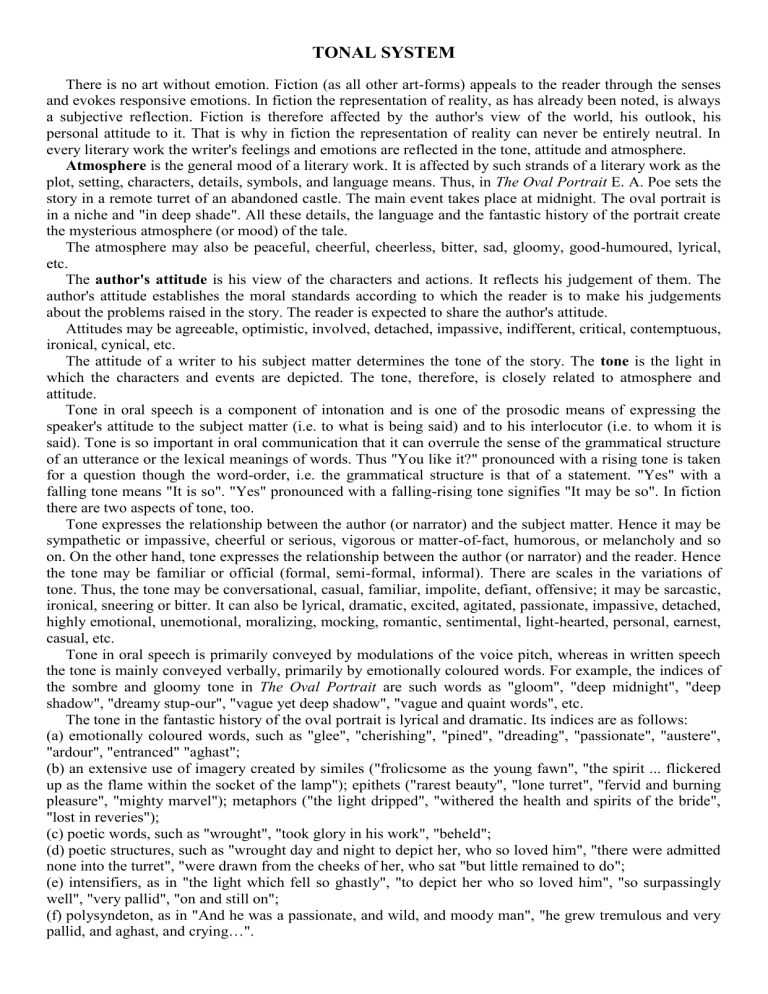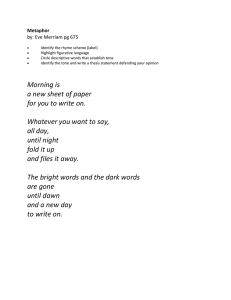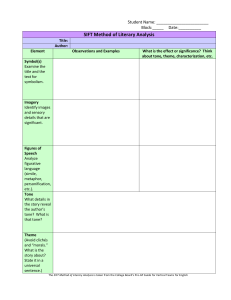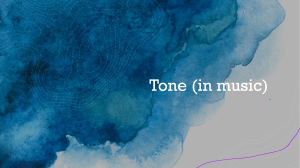Tonal System in Literature: Analysis of Tone and Atmosphere
advertisement

TONAL SYSTEM There is no art without emotion. Fiction (as all other art-forms) appeals to the reader through the senses and evokes responsive emotions. In fiction the representation of reality, as has already been noted, is always a subjective reflection. Fiction is therefore affected by the author's view of the world, his outlook, his personal attitude to it. That is why in fiction the representation of reality can never be entirely neutral. In every literary work the writer's feelings and emotions are reflected in the tone, attitude and atmosphere. Atmosphere is the general mood of a literary work. It is affected by such strands of a literary work as the plot, setting, characters, details, symbols, and language means. Thus, in The Oval Portrait E. A. Poe sets the story in a remote turret of an abandoned castle. The main event takes place at midnight. The oval portrait is in a niche and "in deep shade". All these details, the language and the fantastic history of the portrait create the mysterious atmosphere (or mood) of the tale. The atmosphere may also be peaceful, cheerful, cheerless, bitter, sad, gloomy, good-humoured, lyrical, etc. The author's attitude is his view of the characters and actions. It reflects his judgement of them. The author's attitude establishes the moral standards according to which the reader is to make his judgements about the problems raised in the story. The reader is expected to share the author's attitude. Attitudes may be agreeable, optimistic, involved, detached, impassive, indifferent, critical, contemptuous, ironical, cynical, etc. The attitude of a writer to his subject matter determines the tone of the story. The tone is the light in which the characters and events are depicted. The tone, therefore, is closely related to atmosphere and attitude. Tone in oral speech is a component of intonation and is one of the prosodic means of expressing the speaker's attitude to the subject matter (i.e. to what is being said) and to his interlocutor (i.e. to whom it is said). Tone is so important in oral communication that it can overrule the sense of the grammatical structure of an utterance or the lexical meanings of words. Thus "You like it?" pronounced with a rising tone is taken for a question though the word-order, i.e. the grammatical structure is that of a statement. "Yes" with a falling tone means "It is so". "Yes" pronounced with a falling-rising tone signifies "It may be so". In fiction there are two aspects of tone, too. Tone expresses the relationship between the author (or narrator) and the subject matter. Hence it may be sympathetic or impassive, cheerful or serious, vigorous or matter-of-fact, humorous, or melancholy and so on. On the other hand, tone expresses the relationship between the author (or narrator) and the reader. Hence the tone may be familiar or official (formal, semi-formal, informal). There are scales in the variations of tone. Thus, the tone may be conversational, casual, familiar, impolite, defiant, offensive; it may be sarcastic, ironical, sneering or bitter. It can also be lyrical, dramatic, excited, agitated, passionate, impassive, detached, highly emotional, unemotional, moralizing, mocking, romantic, sentimental, light-hearted, personal, earnest, casual, etc. Tone in oral speech is primarily conveyed by modulations of the voice pitch, whereas in written speech the tone is mainly conveyed verbally, primarily by emotionally coloured words. For example, the indices of the sombre and gloomy tone in The Oval Portrait are such words as "gloom", "deep midnight", "deep shadow", "dreamy stup-our", "vague yet deep shadow", "vague and quaint words", etc. The tone in the fantastic history of the oval portrait is lyrical and dramatic. Its indices are as follows: (a) emotionally coloured words, such as "glee", "cherishing", "pined", "dreading", "passionate", "austere", "ardour", "entranced" "aghast"; (b) an extensive use of imagery created by similes ("frolicsome as the young fawn", "the spirit ... flickered up as the flame within the socket of the lamp"); epithets ("rarest beauty", "lone turret", "fervid and burning pleasure", "mighty marvel"); metaphors ("the light dripped", "withered the health and spirits of the bride", "lost in reveries"); (c) poetic words, such as "wrought", "took glory in his work", "beheld"; (d) poetic structures, such as "wrought day and night to depict her, who so loved him", "there were admitted none into the turret", "were drawn from the cheeks of her, who sat "but little remained to do"; (e) intensifiers, as in "the light which fell so ghastly", "to depict her who so loved him", "so surpassingly well", "very pallid", "on and still on"; (f) polysyndeton, as in "And he was a passionate, and wild, and moody man", "he grew tremulous and very pallid, and aghast, and crying…". The fantastic history is remarkably rhythmical due to the numerous parallel constructions ("loving and cherishing all things, hating only..., dreading only ..."), anaphora ("But she was humble ... But he ... "), doublets ("all light and smiles", "humble and obedient", "from hour to hour", "from day to day"), triplets ("she saw, and loved, and wedded the painter", "he, passionate, studious, austere", "pallet and brushes and other toward instruments", "passionate, and wild, and moody"), alliteration of sonorants ("all light and smiles, and frolicsome as the young fawn, loving", "yet she smiled on, and still on uncomplainngly"). The syntax and the subtle choice of vocabulary seem to obey strict orderly arrangement which results in brilliant rhythm, a lyrical and dramatic tone, a style which is characteristic of "poetic prose" i.e. an elaborately constructed prose with devices of poetry. Tone-shifts often occur in fiction and may accompany not only a change in the subject, but also a change in the narrative method or in the style. In The Oval Portrait tone-shifts accompany the changes in both the narrative method and style (the first part of the tale is a first-person narration with stylistic features typical of emotive prose, whereas the second part is a third-person narration written in the conventional style of English folk tales). M. Khrapchenko noted that one should distinguish between the prevailing tone of a literary work and emotional overtones, which may accompany particular scenes in the story. They all form a "tonal system" which reflects the changes of the narrator's attitude to his subject matter. In The Cop and the Anthem the emotional overtones vary as the plot unfolds. The tone is humorous in the following passage: "If he could reach a table in the restaurant unsuspected success would be his... The total would not be so high as to call forth any supreme manifestation of revenge from cafe management; and yet the meat would leave him filled and happy for the journey to his winter refuge". The tone is dramatic in "He would pull himself out of the mire; he would make a man of himself again; he would conquer the evil that had taken possession of him..." But the prevailing tone of the story is ironic. It is produced by the numerous cases of verbal irony in the narrative and reflects the author's attitude to the problem raised. As stated above, the tone expresses not only the relationship between the narrator and the subject matter, but also the relationship between the narrator and the reader. The narrator may establish an intimate, personal, or formal relationship with the reader. Hence he may discourse at ease and assume a familiar tone, or he may retain a relative distance and narrate in an official tone. The indices of this aspect of tone are also linguistic. The official tone is set up by words and idioms that have an official ring, e.g. "relevant" (for "important"), "up to the present time" (for "up to now"), "Permit me to inform you" (for "Let me tell you"). It may be set up by carefully organized syntax and carefully expressed ideas admitting no deviations from the standard. In general, the official tone accompanies narratives with a well-defined progression of ideas. The familiar tone is established by features of the spoken language, the conversational style in particular. To these features belong colloquial words and idioms. Informality of tone may be achieved by the occurrence of very formal language alongside jargonisms and slang, without its being linguistically inappropriate, since that is a characteristic feature of conversation. Delaying formulas (e.g. "sort of", "well", "shall I say"), colloquial parenthetic phrases (e.g. "you know what I mean"), disregard of the end focus principle by placing the nucleus not in final position (e.g. "Fine you think it is") — all contribute to the establishment of a personal relationship between the narrator and the reader, at the same time they set up a familiar tone. It ought to be added that in fictional speech such signals also function as effective means of characterization, individualization and verisimilitude. The familiar tone in J. Thurber's amusing story The Night the Bed Fell is maintained by an abundance of means traditionally used in spoken conversational style. Among them are colloquial idioms ("one of those affairs" for "a cot", "a mighty jerk"), colloquial words ("wobbly", "bawl", "yell", "quit"), repetition which is generally avoided in other styles ("exchanged shout for shout", "By this time my toother, still shouting, pursued by Herman, still shouting, was trying to ..."). The narrator is at his ease and sets up a very personal relationship with the reader assuming an informal tone which is in taping with the domesticity of the subject of his narrative. The tone of the story is familiar, on the one hand, and vigorous, excited and humorous, on the other. Deliberate exaggerations ("with a tremendous banging crash"), unexpected comparisons ("The situation was finally put together like a gigantic jigsaw puzzle"), the prevalence of physical descriptions containing vocabulary which appeals to our hearing ("racket", "noise", "shouts", "uproar", "howl", "wail", "bawl", "scream", "batter", "bang", "crash", "bark", "creakings", "whistle"' "tinkle"), and to our sight ("piled her valuables in a neat stack", "crawled into bed") contribute greatly to the humorous effect the story produces. Thus, the main indices of tone in fiction are the author's choice of words and structures, stylistic devices and setting. Finally, it should be stated that tone, attitude and atmosphere are important elements of any literary work, which affect the reader's emotional response. The analysis of tone, attitude and atmosphere is a move towards the underlying thoughts and ideas contained in the work; it can be seen as a link between the surface content and all that lies beneath it. Answer the questions: 1. What is the atmosphere of a literary work? What atmosphere can the author create in a story? What determines the general mood of a literary work? 2. What is the author’s attitude? What attitudes may be established by writers? 3. What is the tone of a literary work? What does it express? What tone can be assumed in a story? How is the tone conveyed in literature? 4. What elements form a “tonal system”? What does it reflect?




